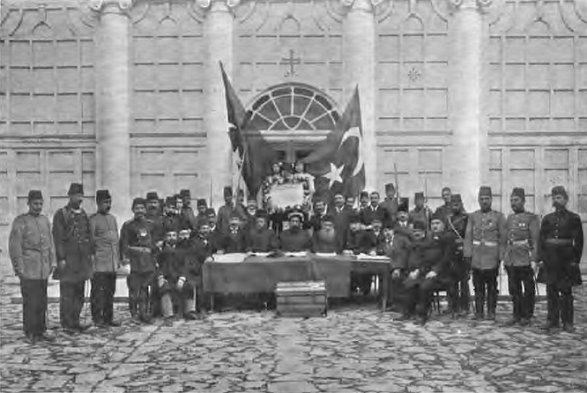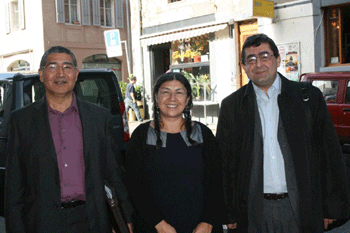
Pan-Armenian Declaration on the Centennial of the Armenian Genocide as a Threat to World Peace and Security [1]
On 29 January 2015, The Armenian State Commission on the Coordination of Events Dedicated to the 100th Anniversary of the Armenian Genocide, in consultation with its regional committees in the Diaspora gave a declaration, which is by itself a crime against humanity. [2]
This declaration is also a threat to world peace and security and is null for the United Nations system and the World international law order.
When Armenia applied for the membership in the United Nations, Levon Ter-Petrosian on behalf of the Republic of Armenia declared that the Republic of Armenia accepted the obligations contained in the Charter of the United Nations and solemnly undertakes to fulfil them. [3] With this declaration, Armenian state instead of fulfilling his responsibilities to the United Nations Charter is breaking the Charter of United Nations seriously and this can only be described as a threat to world peace and security.
In paragraph 10 of the Declaration, it is written that “ the role and significance of the Sevres Peace Treaty of 10 August 1920 and US President Woodrow Wilson’s Arbitral Award of 22 November 1920 in overcoming the consequences of the Armenian Genocide.”
The Pan Armenian declaration in fact is a threat to international peace and against the spirit of United Nations’ all efforts to establish peace in the world as the report is against the territorial integrity and sovereignty of Turkish Republic. This declaration is null according to United Nations Charter and the international legal order.
Speaking to Tert.am, Head of the National Assembly’s Committee on Foreign Relations Artak Zakaryan (Armenian Republican Party) said “It first of all contains a huge legal, political and value base: a memory, rebirth, gratitude, as well as reclamation which – in solidarity with one another – successively reflect the Armenian nation’s concerted efforts, including international recognition campaign, state-building, diaspora formation, maintenance of values, the Armenian national identity, accountability demands for legal consequences of genocide prevention on the international agenda and in international law, as well as the efforts to move ahead with the highest pan-national values.,” [4]
The Pan-Armenian Declaration specifies Armenia s territorial claims against Turkey. This is what Director of Modus Vivendi Center, political scientist Ara Papyan said during a February 2 press conference. Ara Papyan said “I believe the Pan-Armenian Declaration serves as a step forward in terms of formulating our claims against Turkey. I attach special importance to the part of the Declaration that recalls the Treaty of Sevres and Woodrow Wilson s Arbitrary Verdict dated 22 November 1920, Papyan said, adding that he doesn’t t remember a time when the issue of territories is emphasized and valued on behalf of the President of the Republic of Armenia. “[5]
With this declaration, Armenian State and Armenian Diaspora tries to legitimize their claims for the conquest of the lands in Turkey by using “Tabula Rasa Doctrine” [6] in a soulful text on Genocide claims without mentioning the killings of more than 500.000 Turkish civilians by the Armenian non-state armed groups. Armenian non-state armed groups aimed of depopulation of Turks in the territories for which they aimed to form an independent state by killing of the civilian Turks and today, we give the name, Ethnic Cleansing by Massacres for the acts of the Armenian non-state armed groups.
Through the wording “the role and significance of the Sevres Peace Treaty of 10 August 1920 and US President Woodrow Wilson’s Arbitral Award of 22 November 1920”, the Declaration tries to indicate that the Treaty of Moscow 16 March 1921 and the Treaty of Kars 13 October 1921 where Turkey’s east borders, as well as those of Georgia, Armenia and Azerbaijan decided, must be “ex iniuria ius non oritur “; a non-recognition which was based on the generally accepted Roman law, illegal acts cannot produce legal results or rights.
Armenians after 1991 claims that their republic is a clean state (Tabula Rasa) and a new bilateral agreement must be made to define frontiers between Armenia and Turkey. [7] This Declaration also aimed to legitimize this effort by sending a copy to the Secretary General of United Nations.
The Armenian report tries to take, without mentioning, the example of the USSR annexation in 1940 of Estonia, Latvia and Lithuania that resulted from the secret agreements of the Nazi-Soviet Non-Aggression Pact of 1939. The majority of states did not recognize the USSR annexation of the Baltic States. This act of non-recognition was due to the application of the Stimson Doctrine of Non-Recognition. [8]
Estonia, Latvia and Lithuania declared their independence and separated from the crumbling Russian Empire in 1918. Peace treaties were signed with USSR in 1920 and Soviet Russia recognized all sovereign rights over the territories of the Baltic States which had formerly belonged to the Russian Empire.
All three Baltic States were admitted as members of the League of Nations, as was the USSR.
Acquisition of territory by force was recognized as the legitimate right of the conqueror until the end of World War I. Efforts were made to limit the acquisition of territory by force through the use of the provisions of the Covenant of the League of Nations in 1919, but this was applicable only amongst the members of the League of Nations. [9]
Not very long thereafter, when Nazi forces had crushed Poland, and the Red Army had seized its part of Poland’s territory, Estonia, Latvia and Lithuania were pressured to conclude Pacts of Mutual Assistance with USSR, which established Soviet Military bases on Baltic territories, and practically signaled the end of sovereignty for the Baltic nations.
After the fall of Paris and the collapse of France in the 2nd World War, the USSR presented ultimatums to all three Baltic States, which resulted in their total occupation by the Red Army. A masquerade of elections under dubious conditions and the supposedly voluntary joining of the Baltic States to the USSR followed this. After the cease of the sovereignty of the Baltic States in such a manner, the League of Nations expelled the USSR from membership according to the Article 16 of its Covenant in June 1940. [10]
The annexation of Baltic States to the USSR was illegal not according the treaties that were signed between the parties, but was illegal mainly to the fact that they were all member of the League of the Nations. Such an annexation was against the Covenant of the League of Nations.
International community legally recognize the borders of Republic of Turkey from the signature of the Lausanne Peace Treaty. Armenian State and Armenian Diaspora claim that in the Lausanne Peace Treaty, the east borders of Turkey is not defined and try to mention in all the documents and in this Declaration, the Sevres Peace Treaty of 10 August 1920 and US President Woodrow Wilson’s Arbitral Award of 22 November 1920 to legitimize their demand of conquest for the east of Turkish territory.
When Turkey becomes a member of the League of Nations, the other members of the League of Nations who were also the signatories of the Sevres Peace Treaty of 10 August 1920 like England, France, Italy and Japan, not only recognized the east borders of Turkish Republic, which was not mentioned in the Lausanne Peace Treaty of 1923 but also they become a guarantor to the territorial integrity of Turkey as written in the Covenant of the League of Nations..
Under international law, recognition of a state by another state until the formation of the League of Nations did not mean to give a guaranty for the territorial integrity and the independence of a state. This is why the League of Nations expelled the USSR from membership according to the Article 16 of its Covenant in June 1940 for the forcible annexation of the Baltic States.
As the Lausanne Peace Treaty, for England, France, Italy and Japan did not give any responsibility for the territorial guaranty to Turkey until Turkey`s membership to the of League of Nations. The majority of states did not recognize the Soviet annexation of the Baltic States as this act of non-recognition was due to the application of the Stimson Doctrine of Non-Recognition. The Stimson Doctrine of Non- Recognition of the annexation of the Baltic States to USSR was also recognition of the territorial guaranty of the Turkish Republic by United States of America before forming of United Nations after the 2nd World War.
After formation of the United Nations, all member states obliged to refrain in their international relations from the threat or use of force against the territorial integrity or political independence of any state, or in any other manner inconsistent with the Purposes of the United Nations
With the Declaration, Armenian State acted against article 1 and article 2 of the United Nations Charter. The principle of territorial integrity is an important part of the international legal order and is enshrined in the Charter of the United Nations, in particular in Article 1 and 2.
Article 2 (4) of the United Nations Charter requires all member states to refrain in their international relations from the threat or use of force against the territorial integrity or political independence of any state, or in any other manner inconsistent with the purposes of the United Nations. While the Charter does not define what it actually means by “territorial integrity”, it is now well recognized and reflects the fundamental international objective in the stability of boundaries. In 1986, a chamber of the International Court of Justice considered the principle as one of general international law. [9] This view was confirmed by the “Badinter Commission” regarding the former Yugoslav republics, stating that whatever the circumstances, the right of self-determination must not involve changes to existing frontiers at the time of independence. [12]
The Declaration is against to many resolutions of United Nations such as Declaration on Principles of International Law, concerning Friendly Relations and Co-Operation among States in accordance with the Charter of the United Nations 2625, the Definition of Aggression of 3314, Declaration on the Inadmissibility of Intervention in the Domestic Affairs of States and the Protection of Their Independence and Sovereignty 2131 .
Pan-Armenian Declaration on the Centennial of the Armenian Genocide is a threat to world peace and security as the text not only made racial and religious discrimination by not mentioning the killings of more than 500.000 civil Turks by the Armenian non-state armed groups but also the text contents territorial demand form Turkey.
Armenian State and Armenian Diaspora should give a 2nd Declaration and must clarify that the 1st Declaration does not include any territorial demand with the sentence “the role and significance of the Sevres Peace Treaty of 10 August 1920 and US President Woodrow Wilson’s Arbitral Award of 22 November 1920 in overcoming the consequences of the Armenian Genocide” to prevent any misunderstanding. Also in the 2nd Declaration Armenian State and Armenian Diaspora should mention the killings of more than 500.000 Turks by Armenian non-state armed groups. With this form, Pan-Armenian Declaration on the Centennial of the Armenian Genocide is not only a crime against humanity but a threat to world peace and security as well.
Mehmet Sukru Guzel
Switzerland Representative of Center for International Strategy and Security Studies
[1] Pan-Armenian Declaration on the Centennial of the Armenian Genocidehttp://www.mfa.am/en/interviews/item/2015/01/29/pan_arm_dec_armgen/ 10.02.2015
[2] Mehmet Sukru Guzel, “Pan Armenian Declaration on the Centennial of the Armenian Genocide as a Crime against Humanity “, , 10.02.2015
[3] United Nations General Assembly Document No. A/46/847
[4] 10.02.2015
[5] 10.02.2015
[6] Clean state rule (tabula rasa doctrine upon state succession the new sovereign is absolutely free of any it’s predecessor`s obligations; this theory stresses the discontinuity of all rights and obligations completely and automatically upon state succession. Bello, E.G. “Reflections on Succession of States in the Light of the Vienna Convention on Succession of States in Respect of Treaties”, German Yearbook of International Law, (1980) v. 23, pp. 296-322,p 297, The basic concept is that a newly independent state begins its existence free of the obligations of its predecessor state. Vienna Convention on Succession of States in Respect of Treaties article.17, article 24.
[7] Vladimir D.Vardanyan, “The Issues of Legal Validity of Peace Treaties of Armenia and relating to Armenia: An International Legal Analysis”, Armenian Review, Volume 52, No.1-2, Spring-Summer 2010
[8] Robert Langer, “The Stimson Doctrine and Related Principles in Legal Theory and Diplomatic Practice”, Princeton, Princeton University Press, 1947, p. 313.
[9] Covenant of the League of Nations, 28 April 1919;
Article 10
The Members of the League undertake to respect and preserve as against external aggression the territorial integrity and existing political independence of all Members of the League. In case of any such aggression or in case of any threat or danger of such aggression the Council shall advise upon the means by which this obligation shall be fulfilled.
Article 11
Any war or threat of war, whether immediately affecting any of the Members of the League or not, is hereby declared a matter of concern to the whole League, and the League shall take any action that may be deemed wise and effectual to safeguard the peace of nations. In case any such emergency should arise the Secretary General shall on the request of any Member of the League forthwith summon a meeting of the Council.
It is also declared to be the friendly right of each Member of the League to bring to the attention of the Assembly or of the Council any circumstance whatever affecting international relations which threatens to disturb international peace or the good understanding between nations upon which peace depends.
[10] Article 16
Should any Member of the League resort to war in disregard of its covenants under Articles 12, 13 or 15, it shall ipso facto be deemed to have committed an act of war against all other Members of the League, which hereby undertake immediately to subject it to the severance of all trade or financial relations, the prohibition of all intercourse between their nationals and the nationals of the covenant-breaking State, and the prevention of all financial, commercial or personal intercourse between the nationals of the covenant-breaking State and the nationals of any other State, whether a Member of the League or not.
It shall be the duty of the Council in such case to recommend to the several Governments concerned what effective military, naval or air force the Members of the League shall severally contribute to the armed forces to be used to protect the covenants of the League.
The Members of the League agree, further, that they will mutually support one another in the financial and economic measures which are taken under this Article, in order to minimize the loss and inconvenience resulting from the above measures, and that they will mutually support one another in resisting any special measures aimed at one of their number by the covenant-breaking State, and that they will take the necessary steps to afford passage through their territory to the forces of any of the Members of the League which are co-operating to protect the covenants of the League.
Any Member of the League, which has violated any covenant of the League, may be declared to be no longer a Member of the League by a vote of the Council concurred in by the Representatives of all the other Members of the League represented thereon.
[11] International Court of Justice, Opinion No. 2; ILM (1992) 1497; 92 ILR 167; referring to the internal boundaries of the former Republic of Yugoslavia
[12] http://www.unwatercoursesconvention.org/the-convention/part-ii-general-principles/article-8-general-obligation-to-cooperate/8-1-3-territorial-integrity/ 10.02.2015












